Classic family favourite! This Low FODMAP Lasagna is so meaty, so cheesy; a hunk of carb goodness that just happens to be FODMAP-friendly.
Disclaimer - this is not the recipe for you if you like wet, sloppy lasagne with layers that slip around. This recipe is for discerning types 😏 You like majestically tall, portion-able, toothsome, meaty, cheesy, hunks of carby goodness. It's a family favourite and on regular rotation in our house. It freezes and reheats like a dream. It's the perfect make-ahead meal. If you dropped this off to new parents, or someone in iso, I reckon you'd be pretty popular!
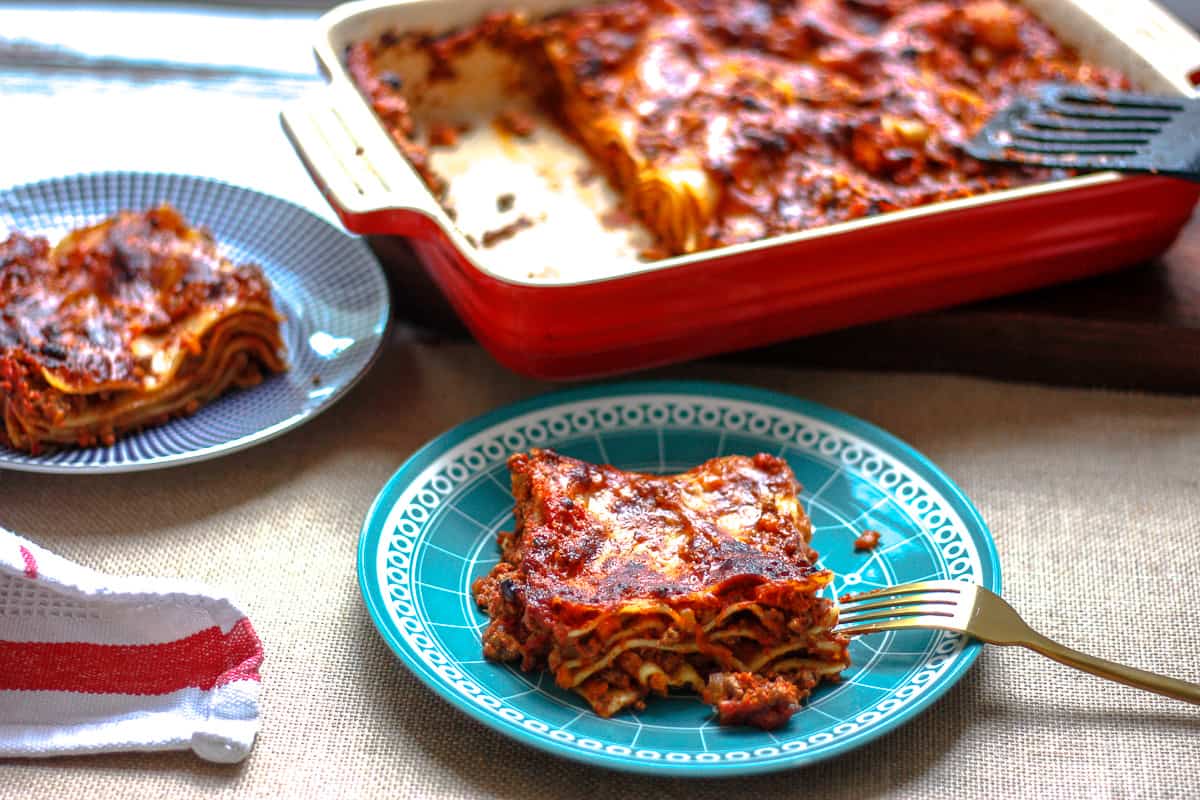
Jump to:
👶Easy to make
If you've made up a batch of my Low FODMAP Bolognese, you'll have enough Bolognese sauce for two of these lovelies. And if you've got some Bolognese already made, this lasagna comes together so easily, you'll feel like you're cheating #winning
💩What's makes this Lasagna FODMAP friendly?
Check out the explanation for my Low FODMAP Bolognese here. Mozzarella and parmesan are naturally low FODMAP. Use gluten-free lasagne sheets if you need to stick to a low FODMAP diet.

🥘 Ingredients
Make sure you've got enough lasagna sheets. The amount will depend on the size of the sheets and how particular you are about filling any gaps. You might need two packets. I've learned the hard way that lasagne come in a variety of sizes and quantity. You need 10 sheets of a 'standard' lasagna. The supermarket own brand I buy (dried pasta) comes in packets of 8 that measure 18x12cm. Each pair of lasagna sheets fit into my 30 x 22 cm baking dish with a 2-3cm gap around the outside. It's not ideal, but I'm OK with that!
Fresh versus dried lasagna sheets
You can use dried or fresh pasta; the cook time will be the same. There is no need to pre-cook either type. They cook in the sauce as the lasagna bakes. Some considerations for each type if you're unsure which one to go for….
Fresh
- easy to cut to size if gaps around the outside bother you
- making your own means lots of extra time and effort. You might prefer to conserve your efforts for making filled pasta recipes
- you will still need 'patchwork skills' to make up each layer of lasagna. It's unlikely that you'll find sheets big enough
Dried
- convenient (bet you've already got some in your pantry)
- cheap
- we need to add a little water around the edges of the lasagna before baking
- need to make sure we push the lasagne sheets into and under the sauce while baking so that they soften
- harder to cut to size if required (see 'Softening sheet' below)
🔪 Instructions
Softening sheets
You don't need to precook dried lasagne sheets before layering. But, you might want to soften the sheets a little so that you can trim to size. Have another baking dish filled with very hot water. Dip dried lasagna for a minute or so, long enough to soften them slightly. You'll be able to slice away any excess without them snapping and breaking into shards. Don't try to do too many sheets at once because they tend to stick together.
Freshly grated mozzarella
I like to grate the mozzarella on the large holes of a box grater. Grating (rather than slicing) makes it easier to dot the cheese more evenly over each layer. Please don't use ready grated; it's not nice!
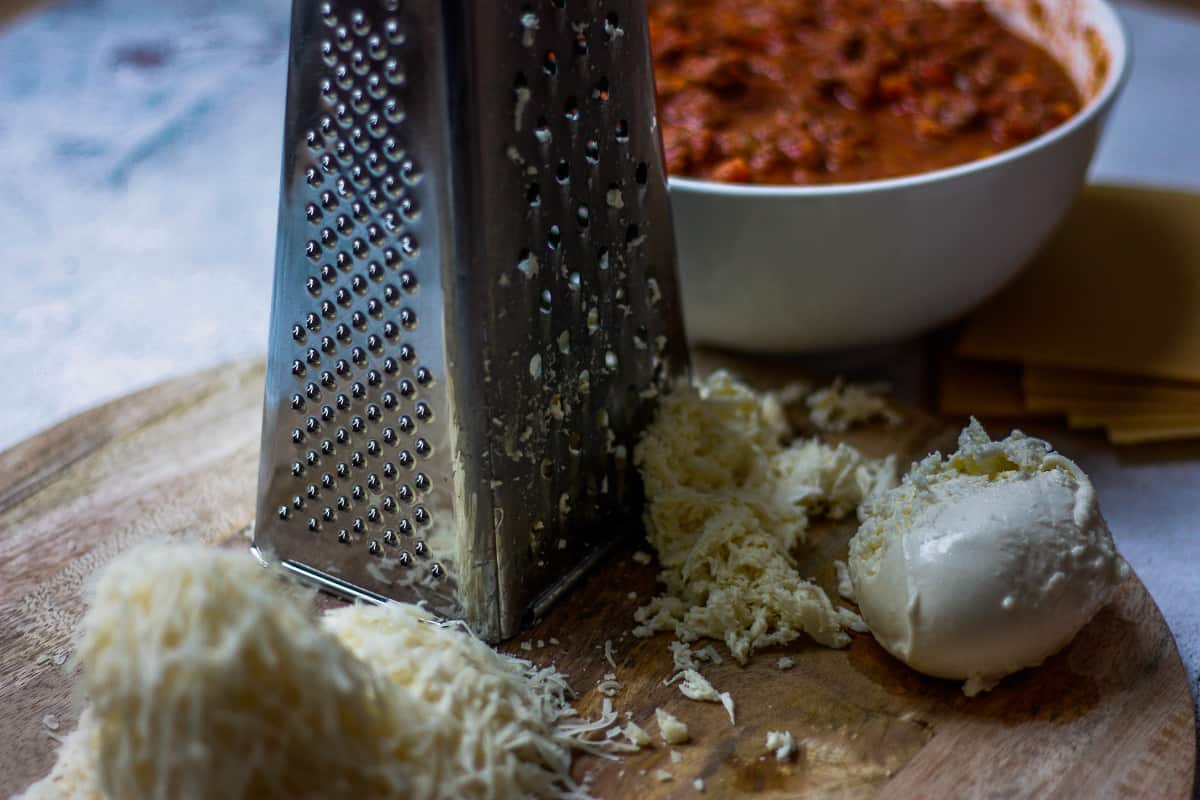
Portion your cheese
Dividing up the cheeses into piles for each layer of the lasagna sounds like extra work. Trust me; it makes for more relaxed layering. No need to remember what number layer you're up to and what fraction of your cheese pile you need. Please don't weigh them, do it by eye.
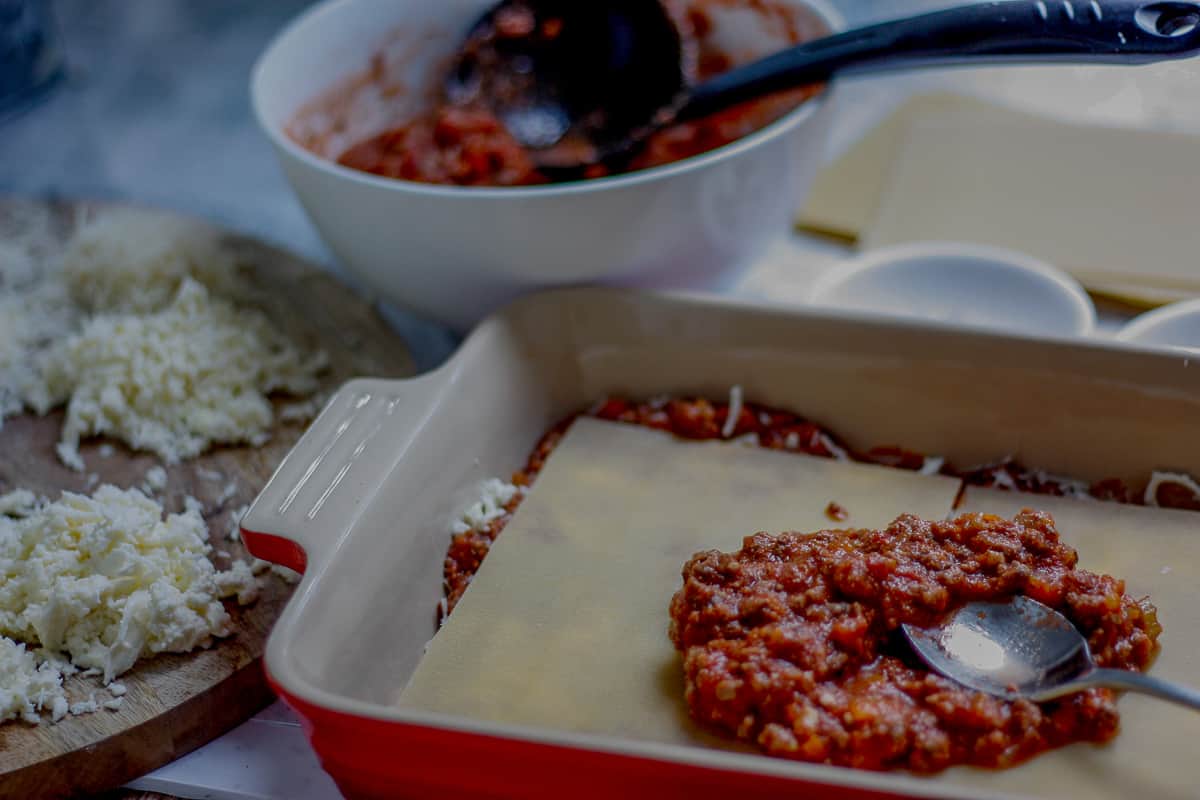
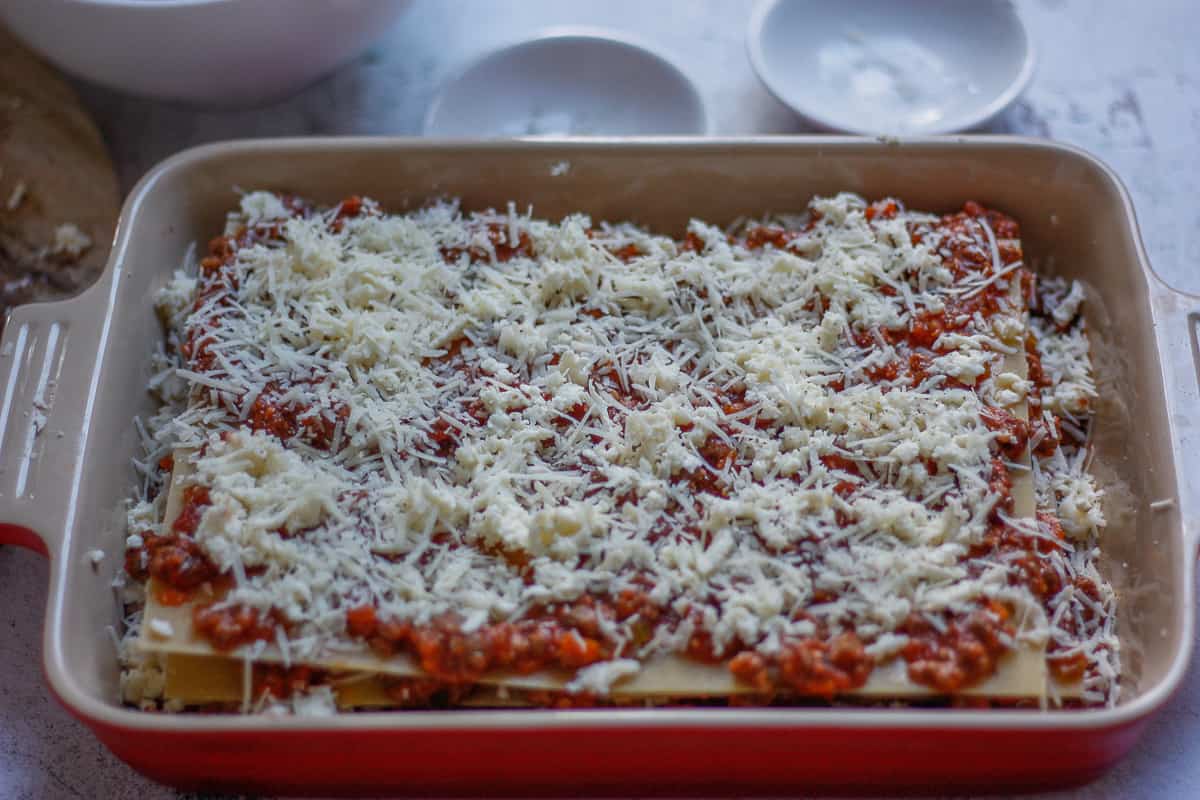
Cover story
We bake for 15 minutes topped with baking paper and foil and 20 minutes 'naked'. The initial covered time
- warms everything through
- melts the cheeses
- prevents the lasagna drying out
The baking paper layer means that you don't lose half your cheese to the foil (which would be very sad). Any that 'sticks' can be easily scraped off and returned to the lasagna when you remove the paper. We use a fish slice or spatula to push down the layers to make sure they're under the sauce before returning to the oven. The final (uncovered) bake gives the lasagna a beautiful bronzed top and some crispy edges.

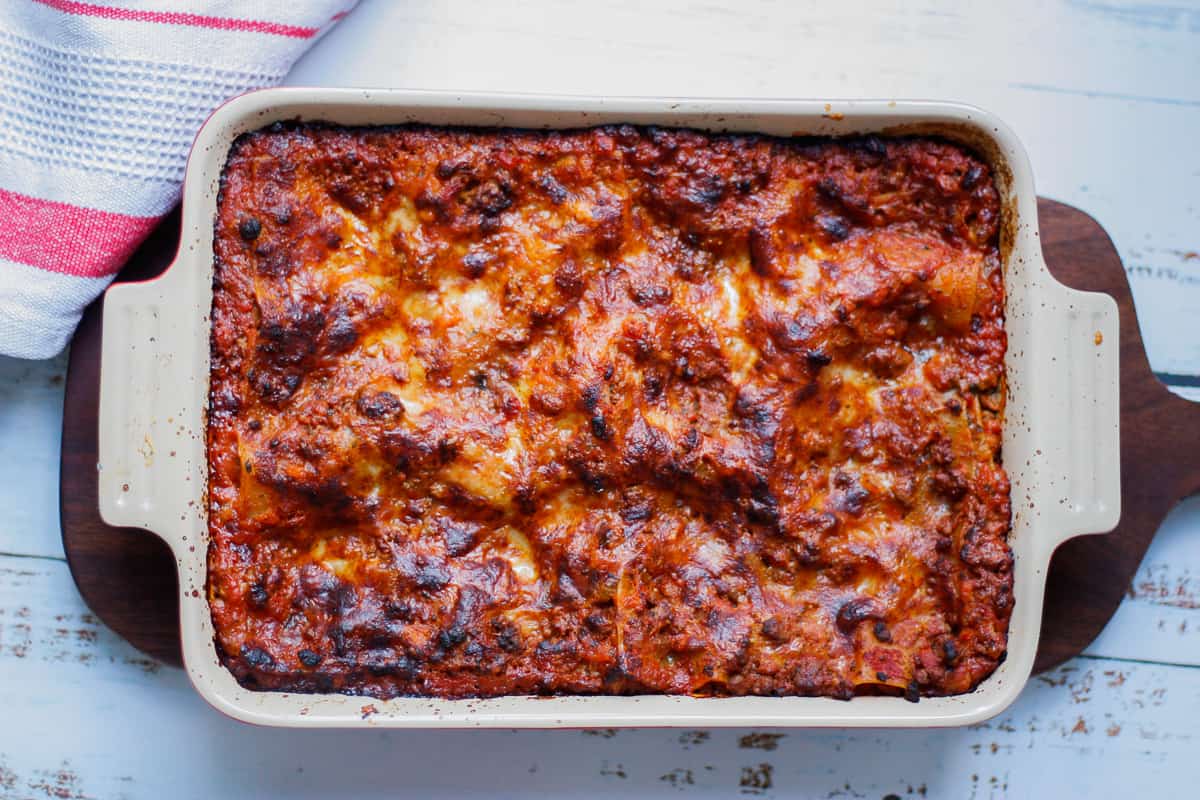
📖 Recipe
Equipment
- Baking dish, rectangular, roughly 30x22cm
Ingredients
* substitutions for low FODMAPPERS
- 1.2 kg Bolognese sauce *half a portion of Low FODMAP Bolognese sauce
- 250 g mozzarella
- 100 g parmesan
- 5 layers lasagna sheets *gluten-free - dried or fresh
- 125g/ml water
Instructions
- Preheat Oven - to 180°C
- Grate & Portion Cheese - coarsely grate the mozzarella & finely grate the parmesan. Roughly divide each cheese type pile into 6 portions, one of which can be slightly bigger (for the top). You'll end up with 6 piles of parmesan and 6 piles of mozzarella.250 g mozzarella100 g parmesan
- Layer - place a ladleful (about 200g) Bolognese in the dish. Distribute it evenly with the back of a spoon or your fingers. It won't form a solid layer. Sprinkle over a portion of parmesan and dot over the grated mozzarella. Season with freshly ground black pepper. Cover with a layer of pasta and repeat. You'll end up finishing with the bigger piles of cheese.1.2 kg Bolognese sauce5 layers lasagna sheets
- Do this step just before baking. Skip it if making in advance. Skip it if using fresh pasta (rather than dried)Water - pour water around the inside edge of the baking dish.125g/ml water
- Cover & Bake - cover the lasagna with a layer of baking paper. Use both hands to firmly press down the lasagna under the paper. Finish with a layer of foil over the baking dish crimped tightly to the top edge. Cook for 15 minutes.
- Uncover & Bake - remove the foil layer (only). Press down on the baking paper layer with a fish slice or spatula. Peel away the paper, returning any stuck on cheese as you go. Cook for another 20 minutes - until the sauce is bubbling, the cheese melted and the lasagna is a bit crispy around the edges.
- Rest - leave to cool in the dish for 10 minutes before slicing and serving.


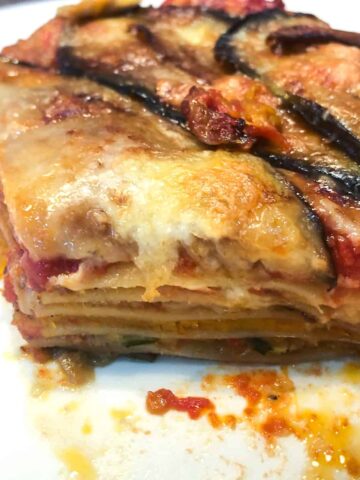


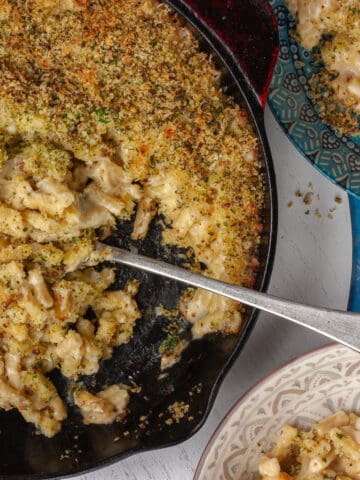
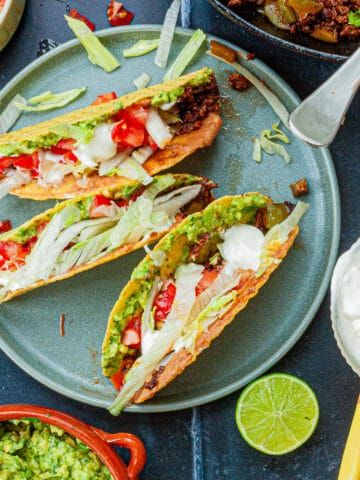
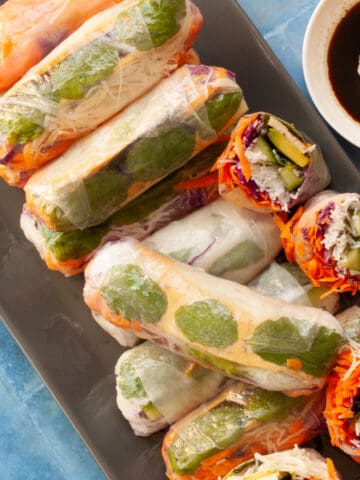

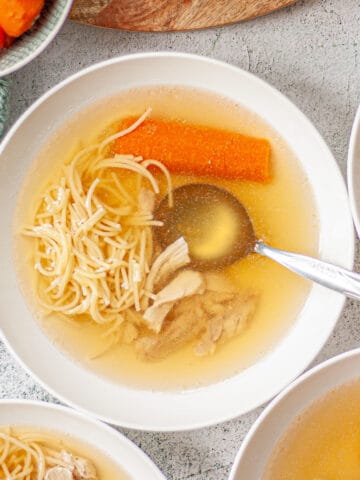
Comments